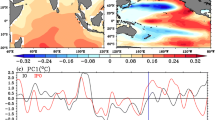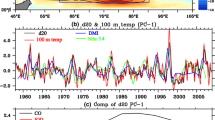Abstract
In this study, the subsurface temperature variability in the Tropical Indian Ocean (TIO) is examined in the Climate Forecast System version 2 (CFSv2) coupled model. The observations and reanalysis show a north–south dominant mode of variability in the TIO subsurface temperature during September–November, the season when the dominant east–west surface mode (Indian Ocean Dipole; IOD) peaks. The nature of the north–south dipole in TIO subsurface temperature is successfully captured by CFSv2. The observations however indicate that this subsurface mode, in general, persists for the next two seasons with stronger signals during December–February, whereas such tenacity is not seen in the model, instead rapid decay of the mode is seen in the model. It is found that the misrepresentation of both equatorial surface wind anomalies and associated Ekman transport as well as the Ekman pumping in the model have close association with the early weakening of the mode in CFSv2. The surface easterlies are generally modulated by the presence of twin anticyclones on both sides of the equator. The model captured these anticyclones with weaker than observed intensity and the northern anticyclone is confined over much smaller region than observed. Association of the subsurface mode with El Niño Southern Oscillation (ENSO) and IOD is further examined in this study. The anomalously prolonged decay phase of El Niño in CFSv2 is found only during the El Niño, IOD co-occurrence years, which was not reported before. This paves way for addressing an important modeling issue which is common in many coupled climate models including CFSv2. The analysis suggests the possible role of coupled air–sea interaction over the TIO on the El Niño cycle in the Pacific. It is also found that the misrepresentation of subsurface variability in CFSv2 during December–February is closely associated with the rapid decay of El Niño forced TIO warming.















Similar content being viewed by others
References
Achuthavarier D, Krishnamurthy V, Kirtman BP, Huang B (2012) Role of Indian Ocean in the ENSO–Indian summer monsoon teleconnection in the NCEP climate forecast system. J Clim 25:2490–2508. https://doi.org/10.1175/JCLI-D-11-00111.1
Alexander MA, Bladé I, Newman M, Lanzante JR, Lau N-C, Scott JD (2002) The atmospheric bridge: the influence of ENSO teleconnections on air–sea interaction over the global oceans. J Clim 15:2205–2231
Balmaseda MA, Mogensen K, Weaver AT (2013) Evaluation of the ECMWF ocean reanalysis system ORAS4. Q J R Meteorol Soc 139:1132–1161. https://doi.org/10.1002/qj.2063
Balmaseda MA, Hernandez F, Storto A, Palmer MD, Alves O, Shi L, Smith GC, Toyoda T, Valdivieso M, Barnier B, Behringer D, Boyer T, Chang Y-S, Chepurin GA, Ferry N, Forget G, Fujii Y, Good S, Guinehut S, Haines K, Ishikawa Y, Keeley S, Köhl A, Lee T, Martin MJ, Masina S, Masuda S, Meyssignac B, Mogensen K, Parent L, Peterson KA, Tang YM, Yin Y, Vernieres G, Wang X, Waters J, Wedd R, Wang O, Xue Y, Chevallier M, Lemieux J-F, Dupont F, Kuragano T, Kamachi M, Awaji T, Caltabiano A, Wilmer-Becker K, Gaillard F (2015) The ocean reanalyses intercomparison project (ORA-IP). J Oper Oceanogr 8(sup1):s80–s97. https://doi.org/10.1080/1755876X.2015.1022329
Chakravorty S, Chowdary JS, Gnanaseelan C (2013) Spring asymmetric mode in the tropical Indian Ocean: role of El Niño and IOD. Clim Dyn 40(5–6):1467–1481. https://doi.org/10.1007/s00382-012-1340-1
Chakravorty S, Gnanaseelan C, Chowdary JS, Luo J-J (2014) Relative role of El Niño and IOD forcing on the southern tropical Indian Ocean Rossby waves. J Geophys Res. https://doi.org/10.1002/2013JC009713
Chambers DP, Tapley BD, Stewart RH (1999) Anomalous warming in the Indian Ocean coincident with El Niño. J Geophys Res 104:3035–3047
Chowdary JS, Gnanaseelan C (2007) Basin wide warming of the Indian Ocean during El Niño and Indian Ocean dipole years. Int J Climatol 27:1421–1438. https://doi.org/10.1002/joc.1482
Chowdary JS, Gnanaseelan C, Xie S-P (2009) Westward propagation of barrier layer formation in the 2006–2007 Rossby wave events over the tropical southwest Indian Ocean. Geophys Res Lett 36:L04607. https://doi.org/10.1029/2008GL036642
Chowdary JS, Parekh A, Kakatkar R, Gnanaseelan C, Srinivas G, Singh P, Roxy MK (2016a) Tropical Indian Ocean response to the decay phase of El Niño in a coupled model and associated changes in south and east-Asian summer monsoon circulation and rainfall. ClimDyn 47(3):831–844. https://doi.org/10.1007/s00382-015-2874-9
Chowdary JS, Parekh A, Sayantani O, Gnanaseelan C, Kakatkar R (2016b) Impact of upper ocean processes and air–sea fluxes on seasonal SST biases over the tropical Indian Ocean in the NCEP climate forecasting system. Int J Climatol 36(1):188–207. https://doi.org/10.1002/joc.4336
Chowdary JS, Parekh A, Srinivas G, Gnanaseelan C, Fousiya TS, Khandekar R, Roxy MK (2016c) Processes associated with the tropical Indian Ocean subsurface temperature bias in a coupled model. J Phys Ocean 46:2063–2875. https://doi.org/10.1175/JPO-D-15-0245.1
De S, Hazra A, Chaudhari HS (2016) Does the modification in ‘‘critical relative humidity’’ of NCEP CFSv2 dictate Indian mean summer monsoon forecast? Evaluation through thermodynamical and dynamical aspects. Clim Dyn 46:1197–1222. https://doi.org/10.1007/s00382-015-2640-z
Dee DP, Uppala SM, Simmons AJ, Berrisford P, Poli P, Kobayashi S, Andrae U, Balmaseda MA, Balsamo G, Bauer P, Bechtold P, Beljaars ACM, van de Berg L, Bidlot J, Bormann N, Delsol C, Dragani R, Fuentes M, Geer AJ, Haimberger L, Healy SB, Hersbach H, Hólm EV, Isaksen L, Kållberg P, Köhler M, Matricardi M, McNally AP, Monge-Sanz BM, Morcrette J-J, Park B-K, Peubey C, de Rosnay P, Tavolato C, Thépaut J-N, Vitart F (2011) The ERA-Interim reanalysis: configuration and performance of the data assimilation system. Q J R MeteorolSoc 137:553–597
Deshpande A, Chowdary JS, Gnanaseelan C (2014) Role of thermocline–SST coupling in the evolution of IOD events and their regional impacts. Clim Dyn 1–12. https://doi.org/10.1007/s00382-013-1879-5
Ek MB, Mitchell KE, Lin Y, Rogers E, Grunmann P, Koren V, Gayno G, Tarplay JD (2003) Implementation of Noah land surface model advances in the National Centers for environmental prediction operational mesoscale Eta model. J Geophys Res 108(D22):8851. https://doi.org/10.1029/2002JD003296
Feng M, Meyers G (2003) Interannual variability in the tropical Indian Ocean: a two-year time-scale of Indian Ocean dipole. Deep-Sea Res 50:2263–2284
Feng M, Meyers G, Wijffels S (2001) Interannual upper ocean variability in the tropical Indian Ocean. Geophys Res Lett 28:4151–4154
Gill AE (1980) Some simple solutions for heat-induced tropical circulation. Q J R Meteorol Soc 106(449):447–462. https://doi.org/10.1256/smsqj.44904
Gnanaseelan C, Vaid BH (2010) Interannual variability in the biannual Rossby waves in the tropical Indian Ocean and its relation to Indian Ocean dipole and El Niño forcing. Ocean Dyn 60(1):27–40
Gnanaseelan C, Vaid BH, Polito PS (2008) Impact of biannual Rossby waves on the Indian Ocean Dipole. IEEE Geosci Remote Sens Lett. https://doi.org/10.1109/LGRS.2008.919505
Gnanaseelan C, Deshpande A, McPhaden MJ (2012) Impact of Indian Ocean dipole and el Niño/southern oscillation wind-forcing on the Wyrtki jets. J Geophys Res Oceans 117(C8):C08005. https://doi.org/10.1029/2012JC007918
Griffies S, Harrison MJ, Pacanowski RC, Anthony R (2004) A technical guide to MOM4. GFDL ocean group technical report no. 5. NOAA/Geophysical Fluid Dynamics Laboratory, Princeton
Karmakar A, Anant P, Chowdary JS, Gnanaseelan C (2018) Inter comparison of Tropical Indian Ocean features in differentocean reanalysis products. Clim Dyn 51(1–2):119–141. https://doi.org/10.1007/s00382-017-3910-8
Klein SA, Soden BJ, Lau NC (1999) Remote sea surface temperature variations during ENSO: evidence for a tropical atmospheric bridge. J Clim 12:917–932
Krishnan R, Ramesh KV, Samala BK, Meyers G, Slingo JM, Fennessy MJ (2006) Indian Ocean–monsoon coupled interactions and impending monsoon droughts. Geophys Res Lett. https://doi.org/10.1029/2006GL025811
Lau NC, Nath MJ (2000) Impact of ENSO on the variability of the Asian–Australian monsoon as simulated in GCM experiments. J Clim 13:4287–4309
Masumoto Y, Meyers G (1998) Forced Rossby waves in the southern tropical Indian Ocean. J Geophys Res 103:27589–27602
Rao SA, Behera SK (2005) Subsurface influence on SST in the tropical Indian Ocean: structure and interannual variability. Dyn Atmos Oceans 39:103–135
Rao SA, Behera SK, Masumoto Y, Yamagata T (2002) Interannual subsurface variability in the tropical Indian Ocean with a special emphasis on the Indian Ocean dipole. Deep Sea Res II49:1549–1572
Roemmich D, Gilson J (2009) The 2004–2008 mean and annual cycle of temperature, salinity, and steric height in the global ocean from the ARGO program. Prog Oceanogr 82:81–100. https://doi.org/10.1016/j.pocean.2009.03.004
Roemmich D, Gilson J (2011) The global ocean imprint of ENSO. Geophys Res Lett 38:L13606. https://doi.org/10.1029/2011GL047992
Roemmich D, The Argo Science Team et al (1998) On the design and implementation of ARGO: an initial plan for a global array of profiling floats. International CLIVAR project office report 21. GODAE International Project Office, Melbourne
Roxy M (2014) Sensitivity of precipitation to sea surface temperature over the tropical summer monsoon region and its quantification. Clim Dyn 43:1159–1169. https://doi.org/10.1007/s00382-013-1881-y
Saha S, Moorthi S, Wu X, Wang J, Nadiga S, Tripp P, Pan HL, Behringer D, Hou Y-T, Chuang H-Y, Mark I, Ek M, Meng J, Yang R (2014) The NCEP climate forecast system version 2. J Clim 27:2185–2208. https://doi.org/10.1175/JCLI-D-12-00823.1
Saji NH, Goswami BN, Vinayachandran PN, Yamagata T (1999) A dipole mode in the tropical Indian Ocean. Nature 401:360–363. https://doi.org/10.1038/43854
Sayantani O, Gnanaseelan C (2015) Tropical Indian Ocean subsurface temperature variability and the forcing mechanisms. Clim Dyn 44:2447–2462. https://doi.org/10.1007/s00382-014-2379-y
Shinoda T, Hendon HH, Alexander MA (2004) Surface and subsurface dipole variability in the Indian Ocean and its relation to ENSO. Deep Sea Res Part I Oceanogr Res Pap 51(619):635. https://doi.org/10.1016/j.dsr.2004.01.005
Srinivas G, Chowdary JS, Gnanaseelan C, Prasad KVSR, Karmakar A, Parekh A (2018) Association between mean and interannual equatorial Indian Ocean subsurface temperature bias in a coupled model. Clim Dyn 50:1659–1673. https://doi.org/10.1007/s00382-017-3713-y
Tozuka T, Yokoi T, Yamagata T (2010) A modeling study of interannual variations of the Seychelles Dome, J Geophys Res. https://doi.org/10.1029/2009JC005547
Uppala SM, Kållberg PW, Simmons AJ, Andrae U, Da Costa Bechtold V, Fiorino M, Gibson JK, Haseler J, Hernandez A, Kelly GA, Li X, Onogi K, Saarinen S, Sokka N, Allan RP, Andersson E, Arpe K, Balmaseda MA, Beljaars ACM, Van De Berg L, Bidlot J, Bormann N, Caires S, Chevallier F, Dethof A, Dragosavac M, Fisher M, Fuentes M, Hagemann S, Hólm E, Hoskins BJ, Isaksen L, Janssen PAEM, Jenne R, McNally AP, Mahfouf J-F, Morcrette J-J, Rayner NA, Saunders RW, Simon P, Sterl A, Trenberth KE, Untch A, Vasiljevic D, Viterbo P, Woollen J (2005) The ERA-40 re-analysis. Q J R MeteorolSoc 131:2961–3012
Vaid B, Gnanaseelan C, Polito P et al (2007) Influence of pacific on southern indian ocean Rossby waves. Pure Appl Geophys 164:1765. https://doi.org/10.1007/s00024-007-0230-7
Wang B, Wu R, Li T (2003) Atmosphere–warm ocean interaction and its impact on Asian–Australian monsoon variability. J Clim 16:1195–1211
Xiang B, Yu W, Li T, Wang B (2011) The critical role of the boreal summer mean state in the development of the IOD. Geophys Res Lett 38:L02710. https://doi.org/10.1029/2010GL045851
Xie S-P, Annamalai H, Schott F, McCreary JP (2002) Structure and mechanisms of south Indian Ocean climate variability. J Clim 15:864–878
Yang J, Liu Q, Xie S-P, Liu Z, Wu L (2007) Impact of the Indian Ocean SST basin mode on the Asian summer monsoon. Geophys Res Lett 34:L02708. https://doi.org/10.1029/2006GL028571
Yokoi T, Tozuka T, Yamagata T (2008) Seasonal variation of the Seychelles Dome. J Clim 21:3740–3754. https://doi.org/10.1175/2008JCLI1957.1
Yokoi T, Tozuka T, Yamagata T (2012) Seasonal and interannual variations of the SST above the Seychelles Dome. J Clim 25:800–814. https://doi.org/10.1175/JCLI-D-10-05001.1
Yu W, Xiang B, Liu L, Liu N (2005) Understanding the origins of interannual thermocline variations in the tropical Indian Ocean. Geophys Res Lett 32:L24706. https://doi.org/10.1029/2005GL024327
Zhou Z-Q, Xie XP, Zhang GJ, Zhou W (2018) Evaluating AMIP skill in simulating interannual variability over the Indo-Western Pacific. J Clim 31:2253–2265. https://doi.org/10.1175/JCLI-D-17-0123.1
Acknowledgements
We thank the Director, ESSO-IITM and Ministry of Earth Sciences (MoES), Government of India for support. The comments from two anonymous reviewers helped us to improve the manuscript considerably. We thank M. K. Roxy for providing the CFSv2 free run data. ORAS4 data is downloaded from http://apdrc.soest.hawaii.edu/. ERA40 and ERA-Interim data are downloaded from ECMWF website. The ARGO gridded data is available from Asia-Pacific data-research center (APDRC) (http://apdrc.soest.hawaii.edu/projects/argo/).
Author information
Authors and Affiliations
Corresponding author
Rights and permissions
About this article
Cite this article
Kakatkar, R., Gnanaseelan, C., Chowdary, J.S. et al. Biases in the Tropical Indian Ocean subsurface temperature variability in a coupled model. Clim Dyn 52, 5325–5344 (2019). https://doi.org/10.1007/s00382-018-4455-1
Received:
Accepted:
Published:
Issue Date:
DOI: https://doi.org/10.1007/s00382-018-4455-1




